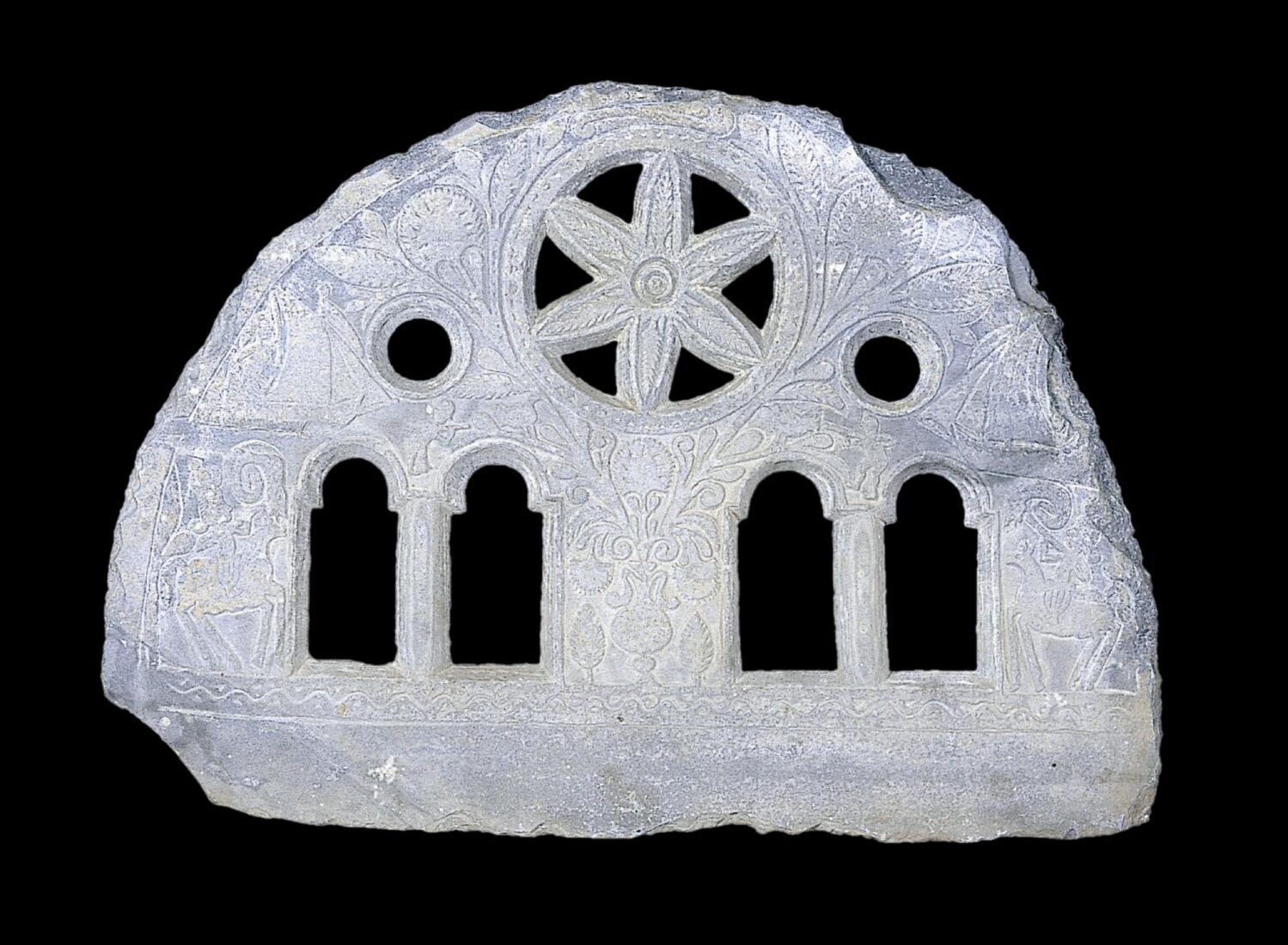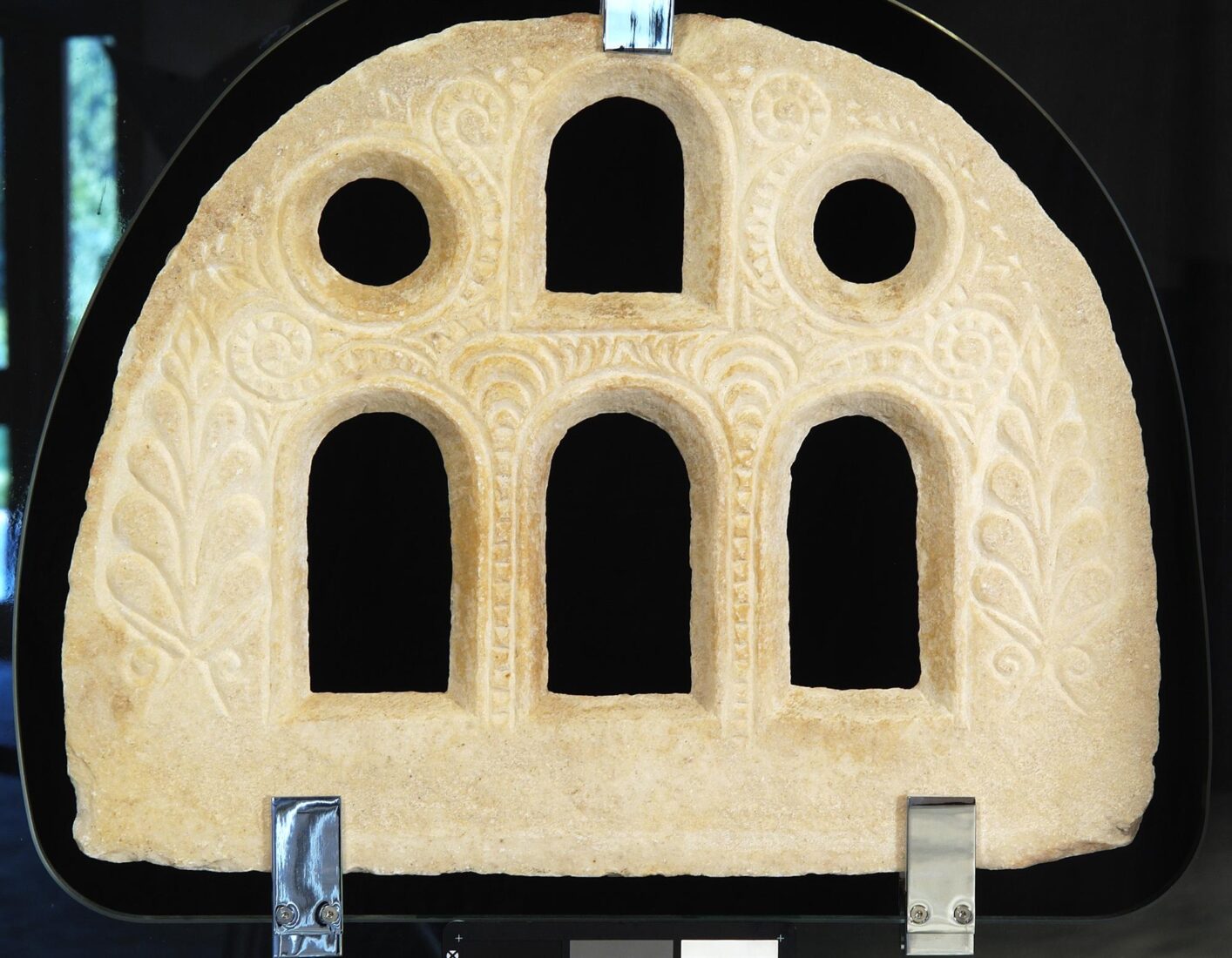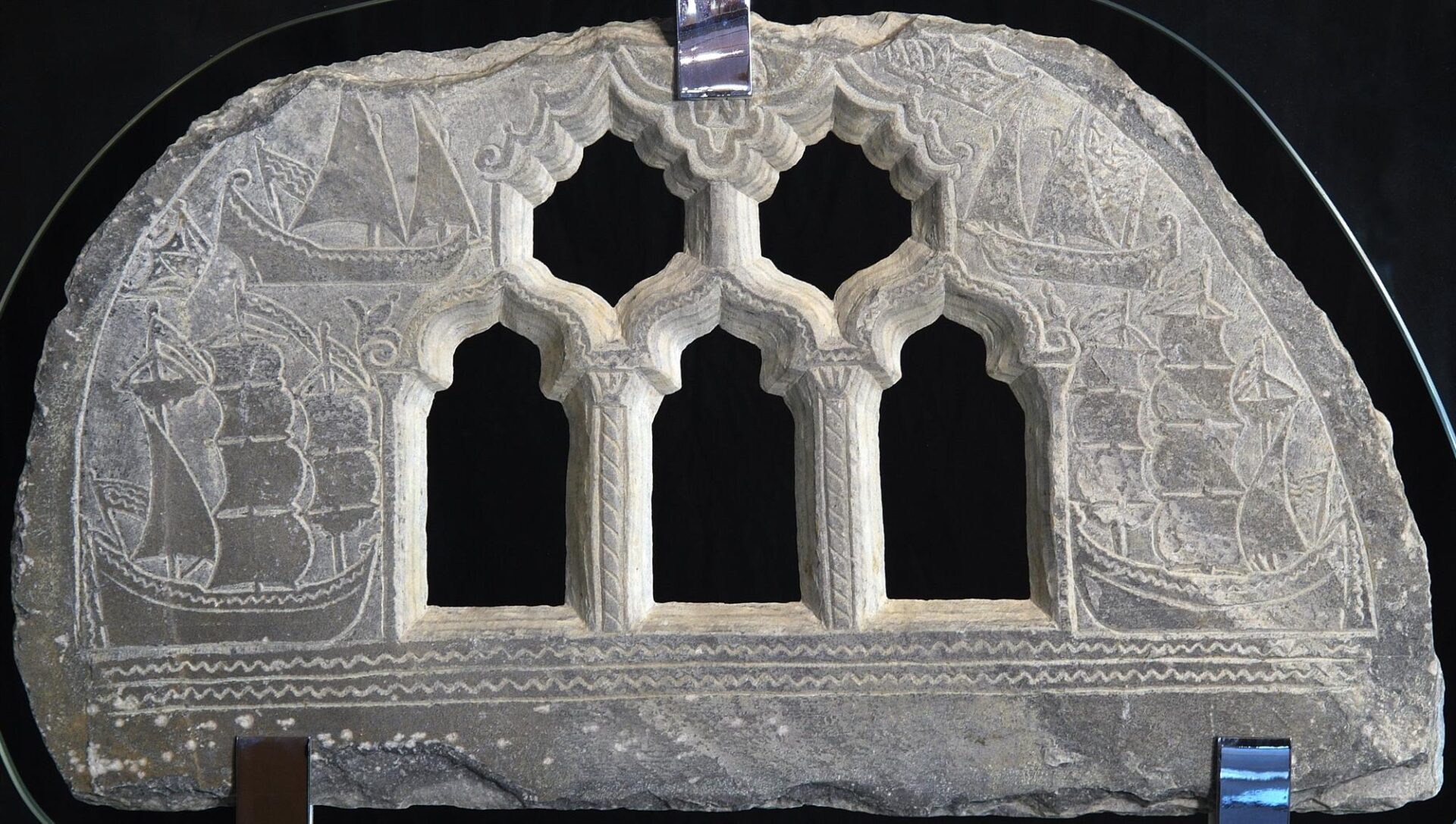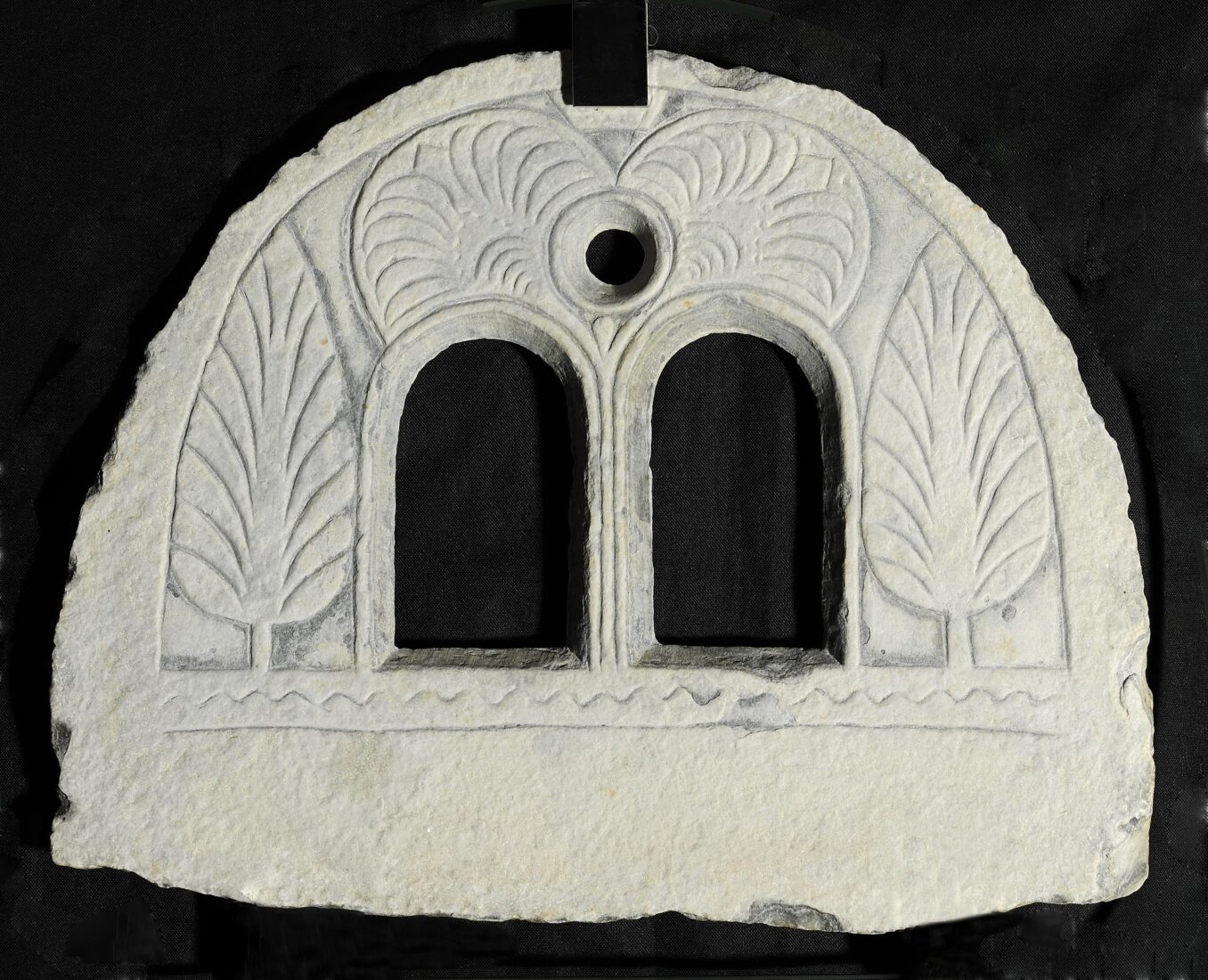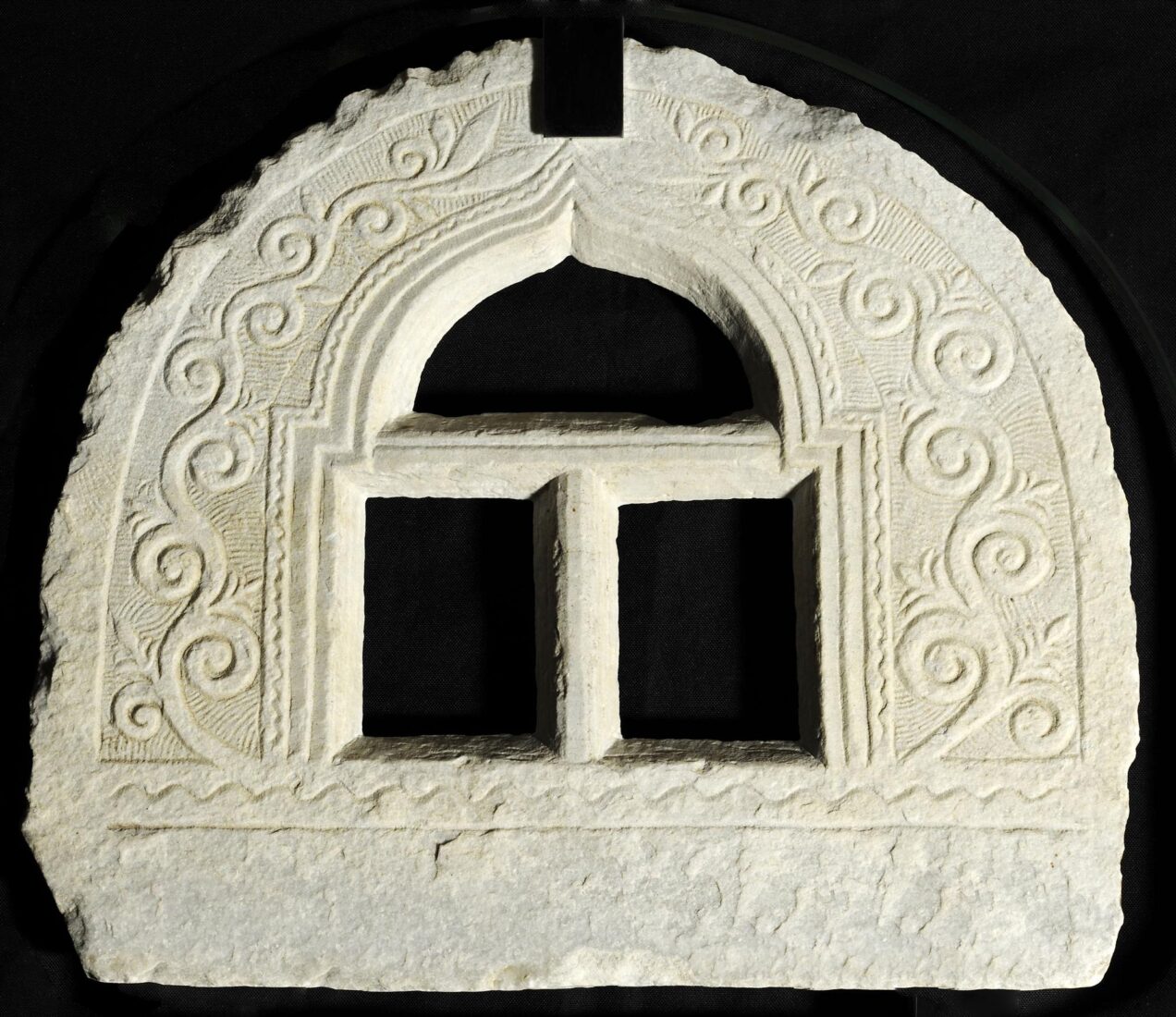Konstantinos Papadimitriou was a folk artist who lived and worked in the 19th century. His works include woodcut figures of War-of-Independence fighters in the popular tradition.
“Georgios Karaiskakis” is depicted in a frontal, serene, but also resolute pose, while the colourisation – a characteristic feature of folk art – accentuates the overall realism. The inscription “This statue of the blessed Karaiskakis was carved and painted by the hand of Konstantinos Papadimitriou, hailing from Agrafa, on June 8, 1829” is also characteristic of the folk culture, not only stating the identity of the portrayed figure, but also the artist’s desire to assert that the work was made by a folk, yet named artist.
The zenith that Greek sculpture achieved in antiquity lost ground with the coming of Christianity. Christianity rejected every feature that came from the idolatrous world, thus relegating sculpture to a secondary, decorative role. In post-Byzantine times and until the early 19th century, sculpture survived in folk art, woodcarving, metal work and stone carving.
Fanlights are a distinct category of stone carving and are encountered primarily in the Cycladic Islands. They are semicircular with perforations and relief designs, and are placed over windows and doors, covering the load-bearing triangular openings, and have multiple functions: practical, because they allow light into the interior; aesthetic, because they have ornamental images; and even magical, because the designs are frequently of a talismanic or apotropaic nature.
The imagery used to decorate fanlights includes religious and human figures, animals, birds and plant motifs, geometric shapes, buildings and ships. Stylistically, they are a combination of elements from the West, the East and folk tradition.
The zenith that Greek sculpture achieved in antiquity lost ground with the coming of Christianity. Christianity rejected every feature that came from the idolatrous world, thus relegating sculpture to a secondary, decorative role. In post-Byzantine times and until the early 19th century, sculpture survived in folk art, woodcarving, metal work and stone carving.
Fanlights are a distinct category of stone carving and are encountered primarily in the Cycladic Islands. They are semicircular with perforations and relief designs, and are placed over windows and doors, covering the load-bearing triangular openings, and have multiple functions: practical, because they allow light into the interior; aesthetic, because they have ornamental images; and even magical, because the designs are frequently of a talismanic or apotropaic nature.
The imagery used to decorate fanlights includes religious and human figures, animals, birds and plant motifs, geometric shapes, buildings and ships. Stylistically, they are a combination of elements from the West, the East and folk tradition.
The zenith that Greek sculpture achieved in antiquity lost ground with the coming of Christianity. Christianity rejected every feature that came from the idolatrous world, thus relegating sculpture to a secondary, decorative role. In post-Byzantine times and until the early 19th century, sculpture survived in folk art, woodcarving, metal work and stone carving.
Fanlights are a distinct category of stone carving and are encountered primarily in the Cycladic Islands. They are semicircular with perforations and relief designs, and are placed over windows and doors, covering the load-bearing triangular openings, and have multiple functions: practical, because they allow light into the interior; aesthetic, because they have ornamental images; and even magical, because the designs are frequently of a talismanic or apotropaic nature.
The imagery used to decorate fanlights includes religious and human figures, animals, birds and plant motifs, geometric shapes, buildings and ships. Stylistically, they are a combination of elements from the West, the East and folk tradition.
The zenith that Greek sculpture achieved in antiquity lost ground with the coming of Christianity. Christianity rejected every feature that came from the idolatrous world, thus relegating sculpture to a secondary, decorative role. In post-Byzantine times and until the early 19th century, sculpture survived in folk art, woodcarving, metal work and stone carving.
Fanlights are a distinct category of stone carving and are encountered primarily in the Cycladic Islands. They are semicircular with perforations and relief designs, and are placed over windows and doors, covering the load-bearing triangular openings, and have multiple functions: practical, because they allow light into the interior; aesthetic, because they have ornamental images; and even magical, because the designs are frequently of a talismanic or apotropaic nature.
The imagery used to decorate fanlights includes religious and human figures, animals, birds and plant motifs, geometric shapes, buildings and ships. Stylistically, they are a combination of elements from the West, the East and folk tradition.
The zenith that Greek sculpture achieved in antiquity lost ground with the coming of Christianity. Christianity rejected every feature that came from the idolatrous world, thus relegating sculpture to a secondary, decorative role. In post-Byzantine times and until the early 19th century, sculpture survived in folk art, woodcarving, metal work and stone carving.
Fanlights are a distinct category of stone carving and are encountered primarily in the Cycladic Islands. They are semicircular with perforations and relief designs, and are placed over windows and doors, covering the load-bearing triangular openings, and have multiple functions: practical, because they allow light into the interior; aesthetic, because they have ornamental images; and even magical, because the designs are frequently of a talismanic or apotropaic nature.
The imagery used to decorate fanlights includes religious and human figures, animals, birds and plant motifs, geometric shapes, buildings and ships. Stylistically, they are a combination of elements from the West, the East and folk tradition.
The zenith that Greek sculpture achieved in antiquity lost ground with the coming of Christianity. Christianity rejected every feature that came from the idolatrous world, thus relegating sculpture to a secondary, decorative role. In post-Byzantine times and until the early 19th century, sculpture survived in folk art, woodcarving, metal work and stone carving.
Fanlights are a distinct category of stone carving and are encountered primarily in the Cycladic Islands. They are semicircular with perforations and relief designs, and are placed over windows and doors, covering the load-bearing triangular openings, and have multiple functions: practical, because they allow light into the interior; aesthetic, because they have ornamental images; and even magical, because the designs are frequently of a talismanic or apotropaic nature.
The imagery used to decorate fanlights includes religious and human figures, animals, birds and plant motifs, geometric shapes, buildings and ships. Stylistically, they are a combination of elements from the West, the East and folk tradition.
The zenith that Greek sculpture achieved in antiquity lost ground with the coming of Christianity. Christianity rejected every feature that came from the idolatrous world, thus relegating sculpture to a secondary, decorative role. In post-Byzantine times and until the early 19th century, sculpture survived in folk art, woodcarving, metal work and stone carving.
Fanlights are a distinct category of stone carving and are encountered primarily in the Cycladic Islands. They are semicircular with perforations and relief designs, and are placed over windows and doors, covering the load-bearing triangular openings, and have multiple functions: practical, because they allow light into the interior; aesthetic, because they have ornamental images; and even magical, because the designs are frequently of a talismanic or apotropaic nature.
The imagery used to decorate fanlights includes religious and human figures, animals, birds, plant motifs, geometric shapes, buildings and ships. Stylistically, they are a combination of elements from the West, the East and folk tradition.
The zenith that Greek sculpture achieved in antiquity lost ground with the coming of Christianity. Christianity rejected every feature that came from the idolatrous world, thus relegating sculpture to a secondary, decorative role. In post-Byzantine times and until the early 19th century, sculpture survived in folk art, woodcarving, metal work and stone carving.
Fanlights are a distinct category of stone carving and are encountered primarily in the Cycladic Islands. They are semicircular with perforations and relief designs, and are placed over windows and doors, covering the load-bearing triangular openings, and have multiple functions: practical, because they allow light into the interior; aesthetic, because they have ornamental images; and even magical, because the designs are frequently of a talismanic or apotropaic nature.
The imagery used to decorate fanlights includes religious and human figures, animals, birds and plant motifs, geometric shapes, buildings and ships. Stylistically, they are a combination of elements from the West, the East and folk tradition.
The zenith that Greek sculpture achieved in antiquity lost ground with the coming of Christianity. Christianity rejected every feature that came from the idolatrous world, thus relegating sculpture to a secondary, decorative role. In post-Byzantine times and until the early 19th century, sculpture survived in folk art, woodcarving, metal work and stone carving.
Fanlights are a distinct category of stone carving and are encountered primarily in the Cycladic Islands. They are semicircular with perforations and relief designs, and are placed over windows and doors, covering the load-bearing triangular openings, and have multiple functions: practical, because they allow light into the interior; aesthetic, because they have ornamental images; and even magical, because the designs are frequently of a talismanic or apotropaic nature.
The imagery used to decorate fanlights includes religious and human figures, animals, birds, plant motifs, geometric shapes, buildings and ships. Stylistically, they are a combination of elements from the West, the East and folk tradition.
The zenith that Greek sculpture achieved in antiquity lost ground with the coming of Christianity. Christianity rejected every feature that came from the idolatrous world, thus relegating sculpture to a secondary, decorative role. In post-Byzantine times and until the early 19th century, sculpture survived in folk art, woodcarving, metal work and stone carving.
Fanlights are a distinct category of stone carving and are encountered primarily in the Cycladic Islands. They are semicircular with perforations and relief designs, and are placed over windows and doors, covering the load-bearing triangular openings, and have multiple functions: practical, because they allow light into the interior; aesthetic, because they have ornamental images; and even magical, because the designs are frequently of a talismanic or apotropaic nature.
The imagery used to decorate fanlights includes religious and human figures, animals, birds, plant motifs, geometric shapes, buildings and ships. Stylistically, they are a combination of elements from the West, the East and folk tradition.
The zenith that Greek sculpture achieved in antiquity lost ground with the coming of Christianity. Christianity rejected every feature that came from the idolatrous world, thus relegating sculpture to a secondary, decorative role. In post-Byzantine times and until the early 19th century, sculpture survived in folk art, woodcarving, metal work and stone carving.
Fanlights are a distinct category of stone carving and are encountered primarily in the Cycladic Islands. They are semicircular with perforations and relief designs, and are placed over windows and doors, covering the load-bearing triangular openings, and have multiple functions: practical, because they allow light into the interior; aesthetic, because they have ornamental images; and even magical, because the designs are frequently of a talismanic or apotropaic nature.
The imagery used to decorate fanlights includes religious and human figures, animals, birds and plant motifs, geometric shapes, buildings and ships. Stylistically, they are a combination of elements from the West, the East and folk tradition.
Father of the painter Nikephoros Lytras, Chatziantonis Lytras was a folk marble-cutter.
In the relief depiction shown here, a scene from the everyday life of the Greek countryside is illustrated. The windmill occupies nearly the entire center of the depiction and is framed by a schematically rendered palm tree and a young island woman, who is drawing near the stairs, laden with a sack of wheat. The folk elements are expressed through a flat perspectiveless rendering, a lack of proportions, and the rendering of the young woman, her face shown in three-quarters profile while the rest of her body is in full profile, just as one finds in folk painting. A cross placed high up, in the center of the marble frame, symbolizes divine assistance.
The work, direct, simple and spontaneous, constitutes a characteristic example of folk technique in marble-carving, done just before the appearance of official sculpture in the New Greek state.

